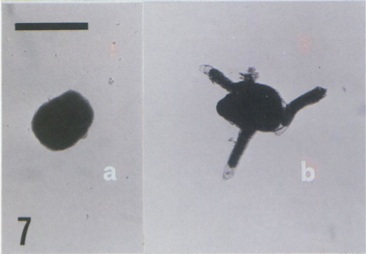The Immortal Jellyfish
Biology 342 Fall 2011
Eric Van Baak
The Adaptive Value of the Reverse Life-Cycle: Immortality in Stress
 There is no evidence as of yet that Turritopsis uses the reverse life-cycle to deliberately "cheat death" in the wild. In their 1996 study, Piraino et al. showed that the reverse life-cycle could be induced by starvation, sharp alterations in salinity or temperature, or physical damage to the medusa's body. In other words, the life cycle reverses in response to environmental trauma. However, it does not reverse absent this trauma; this same study observed no reversal whatsoever in the control group, who received none of the previously mentioned stresses.
There is no evidence as of yet that Turritopsis uses the reverse life-cycle to deliberately "cheat death" in the wild. In their 1996 study, Piraino et al. showed that the reverse life-cycle could be induced by starvation, sharp alterations in salinity or temperature, or physical damage to the medusa's body. In other words, the life cycle reverses in response to environmental trauma. However, it does not reverse absent this trauma; this same study observed no reversal whatsoever in the control group, who received none of the previously mentioned stresses.
Because of this, it is not necessarily accurate to say that Turritopsis uses its reversable life cycle to obtain an indefinite amount of time in which to reproduce. Rather, the reversal comes into play in situations where the organism is unable to survive in medusa form. Piraino et al.'s study mentioned above showed this image of the formation of a cyst (shown as a), an intermediate form taken as the medusa metamorphoses into the polyp, is capable of survival for as much as three months in 14°C water (normal living conditions for Turritopsis is closer to 22°). The cyst can then extrude stolons (seen in b), horizontal projections which form as a precursor to transformation into a polyp, as soon as the temperature is raised to normal levels. The cyst, then, is used as a means of enduring environmental conditions that would prevent the medusa from flourishing.
This is, indeed, an adaptive benefit, enabling organisms that would otherwise be killed by environmental stress to survive and reproduce. But the fact that no kind of "conscious" control over the transformation exists - that the reversal is always linked to major external stresses and apparently never to the internal stress of aging or disease - suggests that the primary value of the reversal does not lie in ensuring that every organism can live forever and produce an indefinite number of offspring (something which would not necessarily be beneficial to the population anyway). Rather, the adaptive value of the behavior is in allowing an individual to live a normal life and reproduce normally, even in environments which would not necessarily allow it. Under these circumstances, any individual organism would have to live a deeply improbable life to be any more or less "immortal" than any other hydrozoan. It seems rather more likely that an individual which repeatedly experienced the sort of trauma required to trigger the life cycle reversal would simply die.